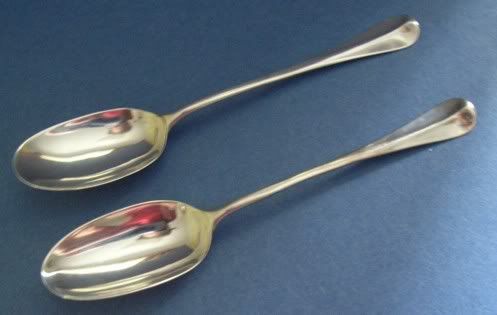Thanks Miles for your comment. It was a bit surprising for me because it is the first time I have rat tail hanoverian spoons and I was not aware of all the variations.
Since my last post I studied the pictures of the other mark and I think I solved the puzzle. In fact there is only 4 out of the 6 spoons which have something readable for this mark.
The 1st one is the less worn. The left side of the outline can be easily identified then we have a curve which is connected to the outline with a small bridge. Then on the upper side we can see 2 loops and below there are segments connected to these loops.

The 2nd mark does not bring more information except that it helps confirm the elements seen in the first one: left side of the outline, curve, bridge, 2 faint loops and connected segments.

The 3rd one, even if worn a lot brings a new piece of information: the curve on the left hand side is continued with a loop. This 3rd mark also contains the two upper loops and the connected segments.

The 4th and last one, is also worn a lot but it is very interesting as it shows the lower part of the mark.

Thanks to the loop identified in the previous mark, we can continue the curve on the left hand side and we recognize the script letter E. If the first letter is in script font, we can guess that another script letter is probable. On the right hand side of this bottom part we can see two very faint circular elements which connect perfectly with the segments seen on the first three marks. It seems reasonable to assume that these circles are bottom loops belonging to the searched letter. Putting these 4 loops and the connecting segments together, we easily deduce that this letter is a script W.
The good thing is that in the index of the maker's marks available in Wyler's book of old silver, there is only one single mark containing EW in script. It is the mark of Edward Workman, a silversmith who was working in Dublin in the beginning of 18C, that is to say exactly during the period where these spoons were marked in Dublin (1715) :

When looking at this mark we can see 2 stars at the top and at the bottom. If I look carefully at the 4th mark above, I can see some very faint element which seems to correspond to the bottom star. Is it just an effect of my imagination ?
I am interested in a confirmation of this analysis and in more information about this maker. There is also the question of the harp crowned which cannot be seen at all on these spoons. Any explanation?
Dinio
.







